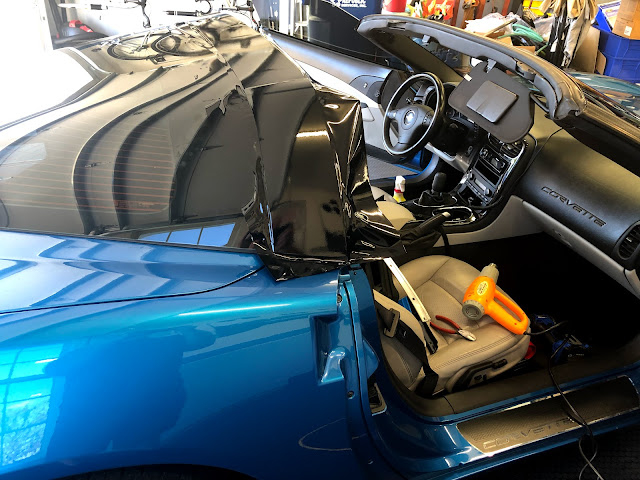Another project I wanted to do this week was covering the "Halo" on the corvette with black vinyl. I had debated on using Scotch 1080 for a carbon fiber look but went with gloss black to better blend in with the tinted windows.
The "Halo" is the blue band that runs over the top of the car between the roof panel and the rear hatch.
I ended up purchasing a section of Avery brand vinyl. When I unrolled it over the roof of the car I noticed the backing in the center of the roll had been creased. I thought it was ruined but later found out that it really has no effect on the usability of the vinyl.
Applying it to the halo was fairly straight forward, I had done a lot of reading prior to trying this. I have some limited experience with applying vinyl, but I have never done anything this large before. The most difficult part was preventing edge failure, or making sure the finished edge isn't under tension where the vinyl could pull up or pull away.
For my first time doing something this large, I'm very happy with how it came out. It really ties the roof to the hatch and gives the car a completely different look. Most people wont notice it because it looks right, its the things that look wrong that people notice. I don't make changes to my car for other people so it really doesn't matter anyway.
Friday, September 6, 2019
Wednesday, September 4, 2019
Vice Cleanup
Tania and I took this week off for a staycation and I have a few projects I want to get done.
A while back I broke the retaining bolt in my HF vice trying to tighten it too much. It pulled the threads right out of the casting holding the nut in place and cracked it. I looked at some of the Wilton BASH vices but read mixed reviews on them, so I got my hands on a mid 90s Wilton 450S.
The vice was mechanically sound other than a few drill starts along the top and some dents in the back jaw where someone beat on it with a hammer.
Thanks to the great information on the Garage Journal forum I was able to take it apart, clean it up and repaint in about six hours. Not a museum restoration I just wanted it to look nice again. The most difficult part and what took the longest was flat filing the back jaw to remove most of the damage. There are still three marks that weren't worth the amount of material I would need to remove for something that was basically cosmetic.
The vice is mounted to a hitch plate which slides into a receiver I welded to the bottom of the work bench. It lets me move the vice out of the way to use both benches.
I like keeping the original machining marks on steel or aluminum whenever possible. The shaft on the front jaw wasn't heavily corroded but wasn't going to wipe clean either. I used a nylon wheel on it which cleaned it very well without leaving any marks like a wire wheel or sand paper would.
A while back I broke the retaining bolt in my HF vice trying to tighten it too much. It pulled the threads right out of the casting holding the nut in place and cracked it. I looked at some of the Wilton BASH vices but read mixed reviews on them, so I got my hands on a mid 90s Wilton 450S.
The vice was mechanically sound other than a few drill starts along the top and some dents in the back jaw where someone beat on it with a hammer.
Thanks to the great information on the Garage Journal forum I was able to take it apart, clean it up and repaint in about six hours. Not a museum restoration I just wanted it to look nice again. The most difficult part and what took the longest was flat filing the back jaw to remove most of the damage. There are still three marks that weren't worth the amount of material I would need to remove for something that was basically cosmetic.
The vice is mounted to a hitch plate which slides into a receiver I welded to the bottom of the work bench. It lets me move the vice out of the way to use both benches.
I like keeping the original machining marks on steel or aluminum whenever possible. The shaft on the front jaw wasn't heavily corroded but wasn't going to wipe clean either. I used a nylon wheel on it which cleaned it very well without leaving any marks like a wire wheel or sand paper would.
Subscribe to:
Comments (Atom)








